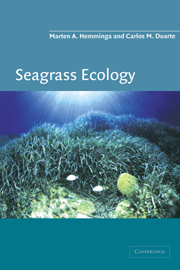3 - Population and community dynamics
Published online by Cambridge University Press: 29 September 2009
Summary
Introduction
Seagrass meadows often appear to the casual observer as static landscapes. However, seagrass meadows are subject to intense dynamics involving the continuous loss and replacement of shoots in the population, which, when in balance, maintain a dynamic equilibrium. Such apparent steady-state conditions can be maintained over extended time periods, leading to long-lived seagrass meadows, such as some Posidonia oceanica meadows, which possibly may persist for > 4000 years in the Mediterranean (e.g. Mateo et al., 1997), and Zostera marina meadows exceeding a millennium in age (Reusch et al., 1999).
The equilibrium maintaining seagrass meadows is, however, often upset, leading to a regression of seagrass meadows, whereby large meadows can be totally lost over a few years (see Chapter 7). In fact, seagrass decline is now a common phenomenon throughout the world (Short & Wyllie-Echeverria, 1996), to the point that the law in various countries now protects seagrass meadows. However, effective protection of seagrass meadows requires an understanding of the regulation of seagrass losses and gains. This is currently the bottleneck to the development of reliable forecasts on the future status of seagrass meadows. Examination of the dynamics of genetic individuals (genets) and patches within the meadow requires knowledge of the life cycles of seagrasses. Seagrass life cycles are similar to those of clonal herbs on land, except that they are entirely confined to the marine realm. However, dispersal processes are remarkably different in the underwater marine environment compared with land.
- Type
- Chapter
- Information
- Seagrass Ecology , pp. 65 - 98Publisher: Cambridge University PressPrint publication year: 2000
- 1
- Cited by



